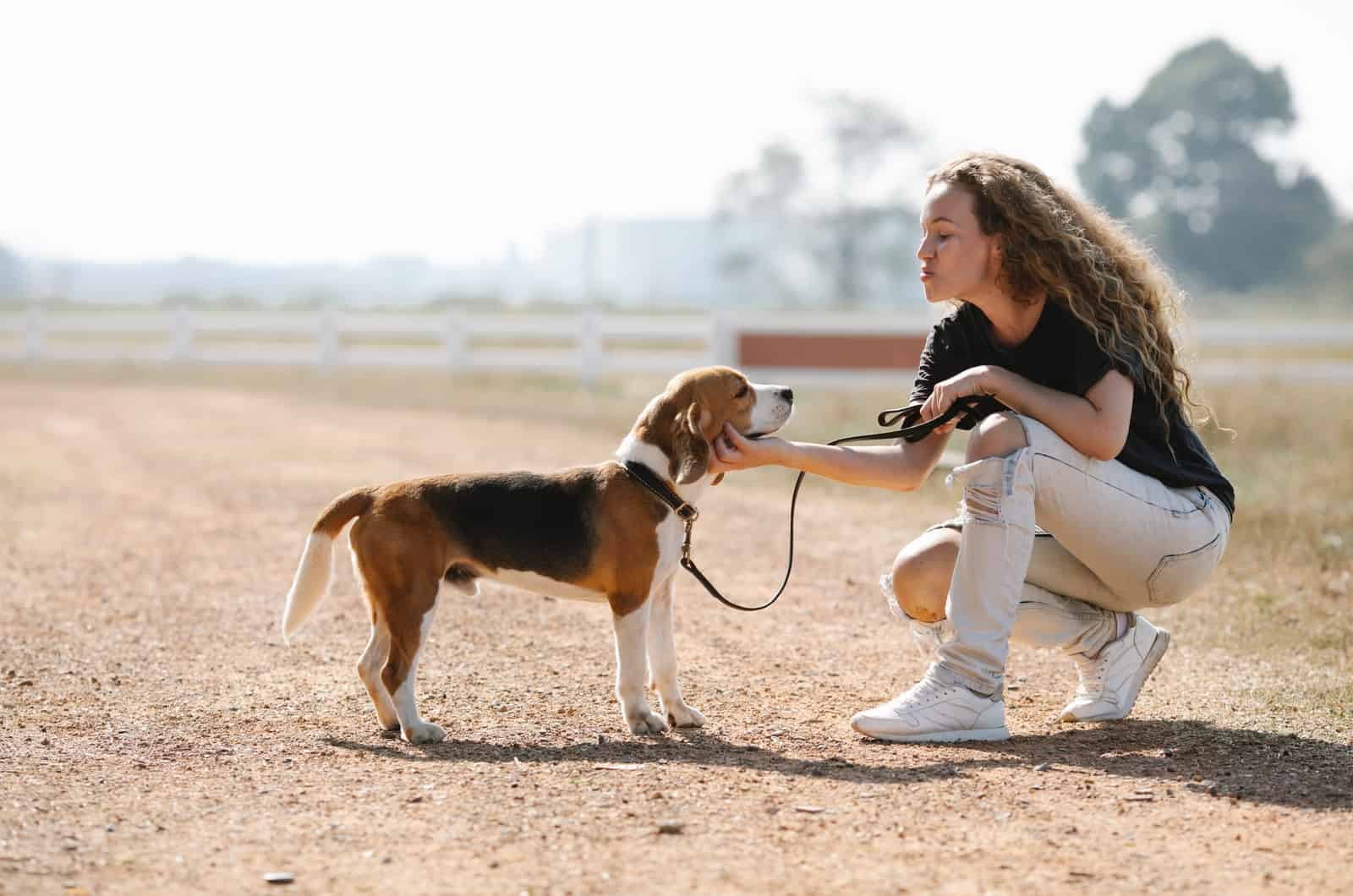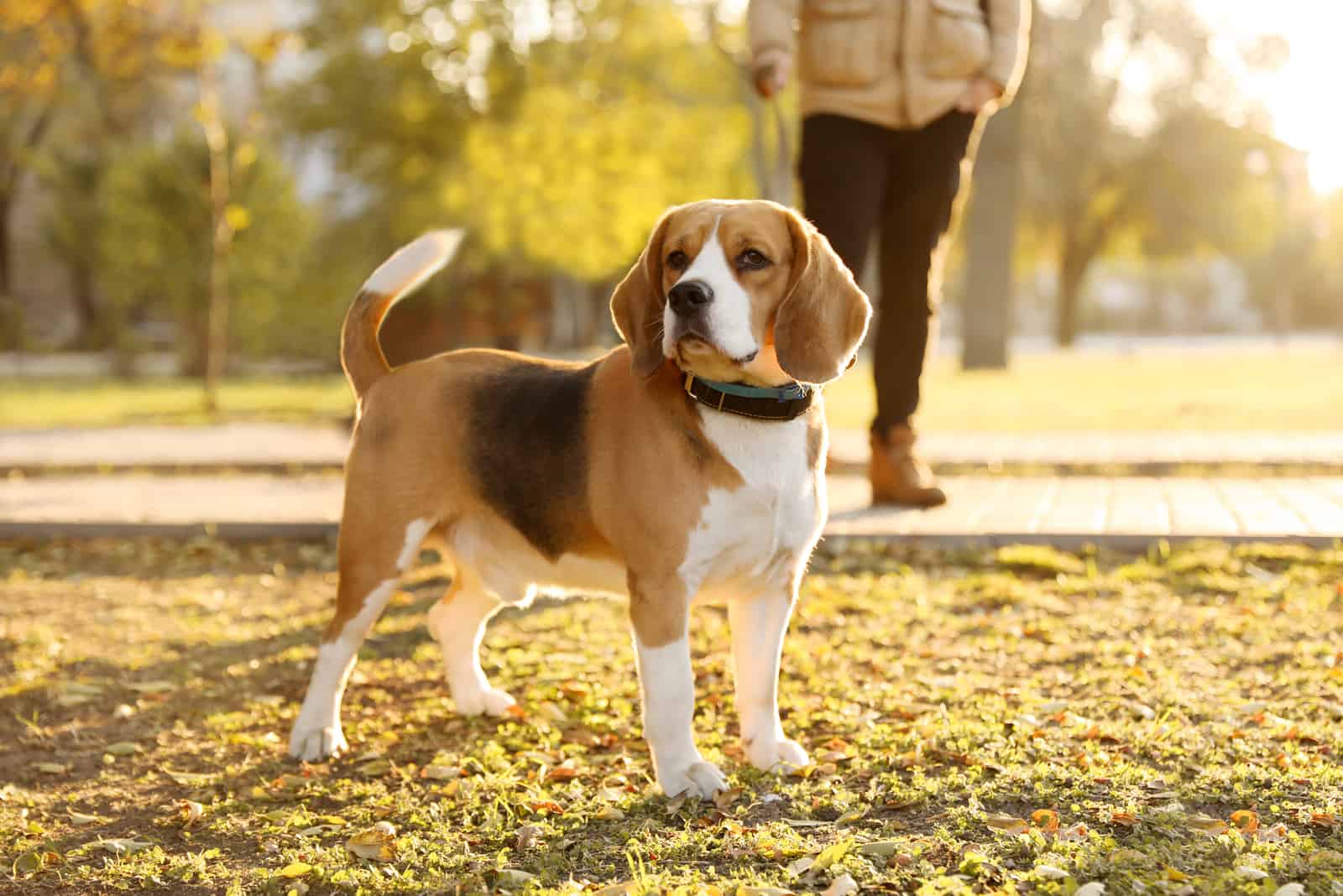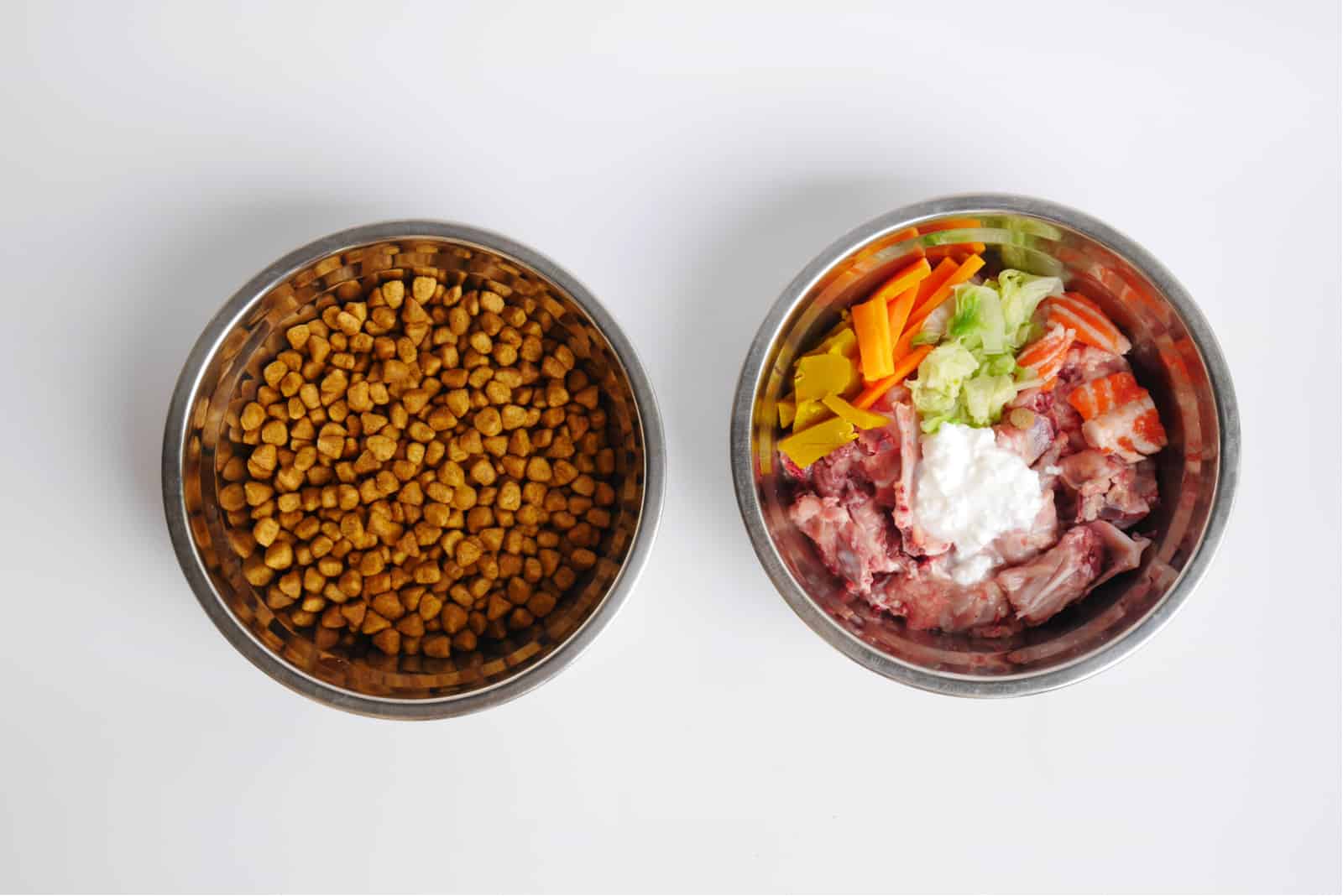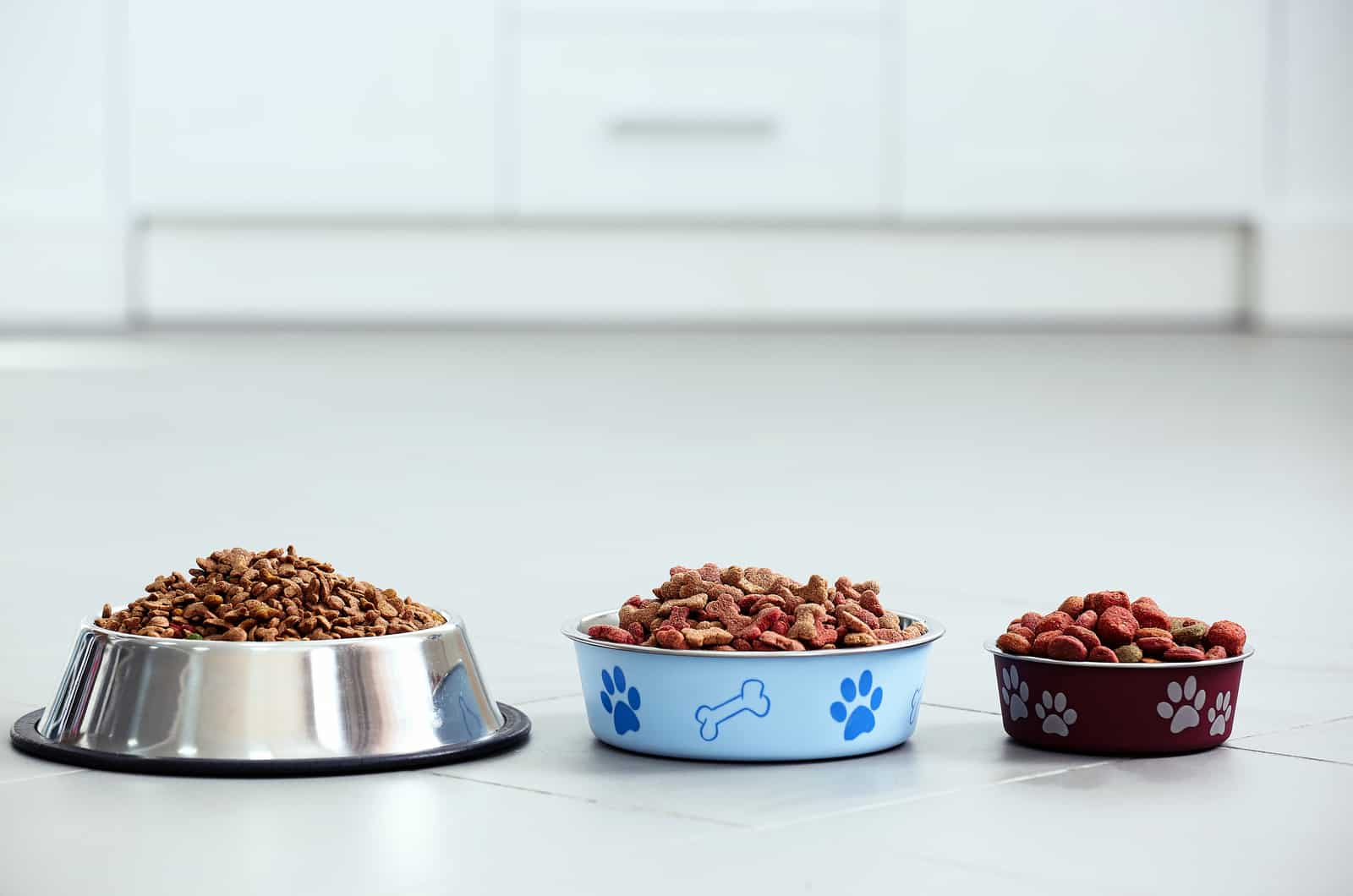Beagles are an absolute dream of a dog, loyal, active and playful, but all that activity needs to be properly supported with a good feeding guide.
Though Beagles do have their own specific feeding needs that need to be met, shown through the Beagle feeding chart that I’m about to present.
Beagle feeding charts help show an average idea of what one Beagle’s diet looks like. How many meals does he get given on the daily, how many calories he should consume and such.
And all of that is separated by the various life stages a Beagle goes through.
But, keep in mind that these values can vary greatly due to a number of different factors.
Age, level of activity and various health issues to name a few with more explained later on in the article.
A Beagle is a pretty active dog too, so expect him to need more calories than other dog breeds of his size.
But, let’s get the basic info out first before we head on out into the nitty gritty.
So, if you’re interested, read on to find out what the standard feeding amounts for Beagles are from a Beagle puppy to his senior dog years as well as find some of the most commonly asked questions pertaining to the subject and the answers to them.
The Beagle Feeding Chart: What It Looks Like
| Age of Puppy | Quantity of Food Per Day | Number of Meals Per Day |
|---|---|---|
| 2 months | 2.5-4.5 ounces | Free Feed |
| 3 months | 2.5-4.5 ounces | 4 |
| 4 months | 3-6 ounces | 4 |
| 5-6 months | 8-12 ounces | 3 |
| 7-8 months | 10-14 ounces | 3 |
| 9-10 months | 9-14 ounces | 2-3 |
| 10-12 months | 8-14 ounces | 2 |
| 1-6 years | 5-13 ounces | 2 |
| 7 years and above | 6.5-11 ounces | 2 |
These measurements are based on using high quality dry dog food as a base as it’s usually the go-to and recommended by veterinarians and pet nutritionists.
You can see the gradual increase in the amount of food throughout the years, capping out at the 7-8 month mark but then gradually dropping off as the years go by.
The reason is because that’s about the point where the dog reaches maturity and slowly has his metabolism slow down.
You can also notice the amount of meals per day decreasing. This is because pups won’t really have an established feeding time so it’s best to just let them chow down until they get their fill, hence the free feed at the start.
But, it’s also because their digestive system hasn’t fully accustomed to solid foods nor is it too big even though the body exerts so much energy, so frequent refills are needed.
As the dog grows, it slows down to less meals but bigger portions until even those portions start shrinking down once the metabolism starts to gradually slow with age.
You can also notice larger estimates between the minimum and maximum daily food amount than you would in other dogs which is specifically attributed to the Beagle’s activity level.
It’s hard to gauge exactly how much is needed, but, if you consult with your dog’s veterinarian or a pet nutritionist about your Beagle’s specific case, they’ll be able to give you a more precise estimate.
What Do Beagles Eat Throughout The Various Life Stages?

Much like with humans, Beagles won’t be eating the same thing for their entire lives, it has to start from somewhere.
Here’s a handy guide that can help you better visualize how it all goes in a lifetime:
0-2 Weeks Of Age
At the start, you won’t be the one doing the feeding for a Beagle pup that’s barely a week or two old, that’s momma Beagle’s job.
It’s your job to feed the mom by giving her enough food to make up for her own nutrients and the nutrients of her kids as they drink their mother’s milk.
If, by the off chance, that one of the pups doesn’t have enough room or gets rejected, you’re going to have to step in.
Aside from having to stimulate the feeling of a momma via heating pad, you’ll also need to provide him with some mother’s milk, or the next best alternative, either through a tube or a bottle if he’s old enough to suckle on it.
3-4 Weeks Of Age
When you have 4 week old Beagle puppies, they’ll usually already start trying to wean off the mother’s breast. If they don’t you can attempt it yourself, but don’t force the issue if they don’t want to yet.
Those that do, however, you still have to help along a little by slowly starting to introduce some puppy dog food into their diets.
It’s usually best to start with a mix that’s one part dog food and 3 parts water to help it simulate a similar consistency to that of mother’s milk.
Then, as time passes, you can slowly adjust the ratios of food and water in the mixture to allow the weaning to progress until the dog’s are ready for solid foods.
While a neat trick though, getting them off the breast isn’t the only reason this is done. These tiny pups haven’t even learned to chew yet, which they will pick up on instinctively as you gradually introduce this weaning method.
Do keep in mind that they’ll still likely need to get a little bit of attention from their mom, but even she’ll slowly start making them wean off.
5-6 Weeks Of Age
At this stage, more pups should’ve taken to the weaning process and be put on this water and dog food mix. While you may still have a few stragglers, all of that should start getting sorted over the next week or so.
As your dog gets more used to his new food, also increase the amount of food he gets as Beagle puppies need a lot of calories daily since they’ll start getting a lot more active at this stage.
However, they’re still young and will still need supervision. Their mom won’t be enough as she may still be busy from time to time so make sure to keep anything bad for him away from him.
7-8 Weeks Of Age
By now, all of the puppies should’ve weaned off their mom’s milk. If not, then it’s time to start being insistent and forcing the issue.
The momma Beagle will be helping out in this endeavor too as she’ll force them to be independent with no more access to her milk.
At this age, the amount of food for puppy feeding should still be increasing gradually to promote healthy weight gain.
Now that they’re 2 months old, they should mostly be on kibble as their choice of Beagle puppy food without it being watered down.
The reason why you’re going for puppy food over some standard adult kibble at this stage is because the puppy food is more calorie-dense which helps feed into their growth.
Expect the Beagles to go around in bursts of energy followed by sleeping periods. Don’t worry, it’s all pretty standard procedure as they burn off the calories and then get a nice reset to do it all again.
It’s at this stage where they’re starting to become more aware of the world around them and they actively try and explore it.
Week 8 is also normally when puppies are rehomed, so if you’re a new Beagle owner, chances are you should be looking here.
9-10 Weeks Of Age
If rehomed, this is still going to be the period where the Beagle puppy yearns for his mom and is adjusting to his new surroundings, so do expect some wailing now and then from the end of week 8 to the entirety of week 9, give or take a few days.
However, he should still be eating regularly, staying at about the same pace as his meal times were for weeks 7 and 8 which amounted to 1.5 cups of food spread out over 3 meals.
Make sure to already set up some form of Beagle feeding guide, a schedule which you can keep to get your canine companion more accustomed to a routine as it’ll help you out in the long run.
That said, don’t overdo it as obesity is one of the biggest issues dogs face given how easy it is to have a puppy eat too much food.
You can, however, rely on some lower calorie treats to reward him every now and then, especially if you’ve started his dog training already.
11-12 Weeks Of Age
At this stage, your puppy can slowly start transitioning to some of the more standard dog food and moving away from the puppy stuff.
That said, you never want to make a shift from one dog food brand to another quickly since the change in flavor and composition is likely to lead to an upset stomach.
Make the shift gradual using the same method needed to wean the puppy off his mother’s milk, by mixing one part of the new kibble with three parts of the old, then slowly tilting the scales in favor of the new stuff.
It’ll make it easier to adapt to new food and won’t cause as much of a problem.
Seeing as your puppy is growing, so too do his nutritional needs.
Make sure you feed him the right amount of food, which, at this point, should be around 1.5 to 2 cups, spread out evenly in 3 meals using the same schedule you’ve used already.
The “right” amount can shift at a moment’s notice too, so make sure to do frequent check-ups with the vet, just in case he starts feeling off or starts gaining or losing weight all of a sudden.
Getting To The First Year

This period remains mostly the same, though your Beagle buddy is now more likely to stomach dry dog food without it getting softened up by water.
This should occur around month 6 when his digestive system advances enough and his teeth grow strong enough.
In the latter half of the year, you can also start diversifying his diet too with some fruits and vegetables, however, consult a pet nutritionist or a veterinarian before you give him anything new.
Things like these should never be snap decisions as they may have heavy consequences for your furry friend if he wasn’t prepared for it.
Year 1 To Year 7
This is the stage where your Beagle can be considered a proper adult and his transition to adult dog food should’ve started.
Seeing as he’s mostly stopped growing, the need for calorie-dense puppy dog food is no longer there and would only become detrimental as he ages further if you continue using it.
The best time to start moving him over is around 10-11 months of age, again, depending on what your Beagle dog’s vet tells you as no drastic change should be done without professional advice.
Depending on your dog’s weight, you should also get a more accurate feeding guide so you can keep your dog on a more balanced diet.
Things shouldn’t change too much otherwise until year 7. Until then, any changes in diet should be introduced slowly as usual to not give his body a shock
Year 7 And Onward
At this age, a Beagle is considered to be a senior dog and the type of food he consumes should change if need be, usually to dog food directed at older dogs.
It doesn’t have to happen right away, but the sooner it’s done, the better so as to not risk obesity which is an even bigger problem in his later years.
Your pooch will still likely be active, but his activity levels will gradually decrease over time as will his nutritional needs.
However, much like anyone growing old, his health may deteriorate, so be on the lookout for any of the usual health problems Beagles and other medium dog breeds face.
Phone up your vet for a check-up if you spot anything unusual.
How Many Calories Do Beagles Need Daily?

Well, the amount of needed calories differs from dog to dog, and it’s no different for your darling doggo.
However, on average, a Beagle puppy needs about 55 calories per pound of body weight which is a measure you’ll go by for his first year of life.
After that it’ll gradually decrease down to about 45 and even less for senior dogs given their slowing metabolism.
But again, as you’ve seen in the Beagle feeding chart, these figures are most certainly not final as many different factors can affect it one way or another.
The Overall Size
Depending on your Beagle’s size, he’ll need to maintain a different body weight that’d be considered healthy for him so he may need to take in more or less than the average amount to keep himself in shape.
The Level Of Activity
Another key factor, one that affects Beagles more than most other dogs given how being active is in their history, being hunting dogs and all.
If you have a particularly active doggo, it stands to reason that he’ll need to eat more as he burns off more calories.
On the other hand, should you have a more sedentary Beagle, then he’ll need a lot less calories per day.
The Dog’s Age
As I’ve already stated above, the daily recommended calorie intake will vary greatly based on the dog’s age, with puppies needing more to facilitate their growth and adults for living a more active life.
Meanwhile, senior dogs have their metabolism slow down which leads to a lower daily calorie requirement.
A Pregnancy
Another thing I’ve mentioned earlier is a pregnancy. While it’ll only affect female dogs for obvious reasons, it’s a well known fact that anyone pregnant tends to have a bigger appetite so she can provide nutrients for both herself and her offspring.
The same goes for when she’s nursing, and for female dogs, that usually means allowing her to free-feed so she can keep up on her own.
Spaying Or Neutering Your Dog
Finally, something drastic like having to spay or neuter your dog can lead to a shift in the needed calorie intake.
It’s not uncommon that, with the lower hormone production levels in a dog’s body after such a process, that they’d need to consume less calories to keep up on a daily basis.
A different factor that can contribute to this that comes as a potential side effect of this process is a depressive episode that can hit them right after getting spayed or neutered, leading to a temporary loss of appetite.
While it’s not usually the biggest culprit, you may notice a difference, make sure to adjust accordingly.
If the effects last too long, it may be best to consult with your vet to see how this can be remedied as it could turn into a more serious problem.
Calculating How Many Calories Your Dog Needs On A Daily Basis

If you want to do the math on your own, you can always use the RER method for calculating the ideal calorie amount for your dog’s daily intake.
RER stands for Resting Energy Requirement and is equal to the necessary daily calorie amount.
For medium dog breeds like the Beagle, the formula is as follows.
30 x (body weight in kilograms) + 70 = RER for medium-sized patients
There’s a different formula for smaller dog breeds, but it’s not necessary in this case.
Do be aware that this is, once again, a rough estimate and you should still adjust accordingly if you see your dog either gaining or losing weight.
Of course, it’s always best to trust a pet nutritionist or a vet on the matter, but this can give you a closer estimate if need be.
What Food Should My Beagle Eat?

While we’ve solved the mystery of calories, there’s still the issue of finding some good food which can be a more challenging task.
You have to squeeze out the best out of every calorie and not just shovel in empty ones which will only end up being detrimental to your canine companion.
That said, there are several factors you should consider when trying to find the ideal type of dog food for your Beagle.
Lots Of Protein
The first ingredient that always gets looked at is the protein, and finding the right one is going to do more for your dog than anything else, especially considering how energetic of a breed the Beagle is.
You’ll want a proper meat source like some good quality beef or chicken, with turkey and fish being decent side options, albeit not as fantastic.
Healthy Fats
Aside from protein, your dog will also need some healthy fats to satisfy their daily nutritional needs, though the ratio should still heavily favor the protein.
You’ll want at least 2 parts protein to one part healthy fats.
A Solid Amount Of Digestible Carbs
Protein usually needs to be followed with a healthy source of carbohydrates and most of the good stuff in dog food comes paired with brown rice as a source as they’re a good source of fiber too.
If not, then try looking for sweet potatoes as it’s a solid alternative.
Avoid Empty Calories
You’ll often be faced with dog food that uses meat by-product, fillers or meals which are usually just there to bloat the calorie count, something that an older dog doesn’t really need.
Plus, it’s not as tasty as proper meat would be and is usually a sign of a low quality dog food brand. Avoid it if possible.
Nutrient And Vitamin Rich
As with any other food, you’ll want something that provides your dog all the benefits that he needs to live a long and healthy life.
This means loading up on various vitamins, minerals and nutrients.
Calcium and phosphorus rank among one of the most vital ones as they help facilitate healthy bones and joints.
Aside from them, you’ll find chondroitin and glucosamine which help keep the joints flexible, even in your dog’s older years.
Of course, omega-3 fatty acids are essential too as they contribute to healthy and hydrated skin as well as a strong and shiny coat among other health benefits.
It’s a nutrient commonly found in flaxseed or fish oil so look for those ingredients to make sure the food you’re buying has it.
No Artificial Ingredients
As with anything else nowadays, you want food to have all-natural ingredients and to be free of artificial preservatives, colors and flavors or any other additives or harmful chemicals for that matter.
Making sure the food is GMO free is also a priority as it’s less healthier than the natural stuff.
Devoid Of Any Common Allergens
If you have a dog with a sensitive stomach, you may want to try avoiding some of the more common allergens like gluten or various grains like corn, wheat or soy that could upset your Beagle’s stomach.
Look for food that’s labeled grain-free and he should be alright for the most part.
Should I Go For Wet Or Dry Dog Food?
For proper Beagle care, you should mainly stick to dry dog food.
It’s easier on the stomach, more nutrient rich and a lot cheaper.
It also helps keep your dog’s teeth clean by fighting plaque and tartar as it gets chewed up.
Wet food, on the other hand, is tastier, but it also stains your Beagle’s teeth and is overall more detrimental to dental hygiene and your budget.
However, it’s not all bad and can be given to your dog every now and then or mixed in with dry dog food. It even contains less calories than the dry stuff in most cases.
Just make sure you don’t break your budget with it.
Food You Should Absolutely Avoid Feeding Your Dog

Beagles aren’t the pickiest of eaters, though mixing it up every now and then will help keep their appetite up and keep things interesting.
However, if you want to introduce new food to your dog’s diet, there are some that you need to avoid at all costs.
Here are some of the worst offenders:
• Xylitol – A sweetener that’s found in most candies and chewing gum and should be avoided at all costs as it can lead to liver failure
• Alcohol – An obvious pick, but one people don’t pay much attention to. This doesn’t just include drinks, but any foods infused with alcohol like various steaks.
• Chocolate – The most infamous dog poison that can cause severe issues like heart problems or death. The main problem is a substance called Theobromine which is found in almost every chocolate
• Caffeine – Another notorious problem substance, one that’s found in almost every snack and is often fatal for dogs, even in small amounts
• Avocadoes – Yes, one of the so-called superfoods is a problem for your dog due to a substance called Persin which can get stuck in their intestines and cause an obstruction, often leading to a fatal outcome
• Garlic and onion – The favored seasoning in almost every human dish is poisonous to dogs. While not as fatal as some others, it can make your dogs anemic
• Spicy foods – Another obvious case. Dogs simply can’t handle spicy foods. The capsaicin is even more damaging to them than it is to a human and can lead to various problems that’ll lead to a mandatory vet intervention
• Raisins and grapes – There are plenty of other fruits to get your dog, these aren’t it as they can cause sickness and even kidney failure in some extreme cases. Steer clear
Is It Better To Allow Free Feeding Or To Stick To The Schedule?

Unless your Beagle is less than 8 weeks old or is pregnant, it’s better to stick to the feeding schedule you’ve hopefully been keeping him on post week 8.
Beagles are energetic, but get overweight just as easily so allowing them access to free-feeding when they usually don’t know when to stop is likely to lead to obesity.
What Is A Good Diet For A Beagle?
I suggest a mix of wet and dry food, some of it being manufactured while the other part of it being homemade food.
The manufactured part is going to provide all of the necessary nutrients and minerals and whatnot, but it’s also going to be an easy to access, familiar taste.
The homemade food, on the other hand, serves as that element that mixes it up every now and then that I mentioned helps keep your dog’s appetite up.
However, before you give anything homemade to your pooch, make sure it contains none of the bad ingredients mentioned above and that you know an estimate of how many calories it has.
While one cheat meal won’t do him any harm, it’s still worth paying attention so it doesn’t get out of hand.
What If My Beagle Refuses To Eat?
If your dog is refusing to eat, it could either mean that he’s full or that something is wrong with him.
Should the problem stick around, call up your vet and schedule a check-up so you can figure out what the source is and how best to treat it.
What’s The Difference Between Puppy, Adult And Senior Dog Food?

Firstly, puppy food is more calorie-dense as it’s meant to give your dog enough resources to grow to a healthy size.
It’s best to stick to the same brand that the Beagle breeders used so as to not upset your pet’s stomach.
It gets cut off when he’s nearing his first birthday and you swap to adult food to reduce the calorie intake.
While adult Beagles will be more active than a puppy would, they also don’t need the excess calories from the puppy variant.
Not to mention the adult food options for dogs are more nutritious and of higher quality.
When your dog reaches his 7th year of age, the adult dog food should slowly be phased out and replaced with food for senior dogs.
Senior dog food contains less protein and fats but has more carbs to help your dog deal with some of his more common health issues related to digestion easier.
Given the slower metabolism, he also doesn’t need that much protein or fats as his body can’t burn through as much given his less active state.
It also allows more room for relevant nutrients like calcium, chondroitin and glucosamine as they help keep joints healthy, as mentioned prior which is one of the most common issues in medium and large dog breeds.
What’s The Best Dog Food For A Beagle?
My personal pick of some high quality food for a Beagle would be the ORIJEN Dog Tundra as it contains everything your canine companion will need at a relatively affordable price.
What Are Some Of The More Common Beagle Health Issues?

Beagles don’t really get many issues related to eating aside from the obesity risk, but there are a few which could make life difficult for them due to said weight.
The main problems are patellar luxation and hypothyroidism.
The former can be a cause of poor joint and bone health which is why I’ve emphasized the need for it several times throughout the article.
It can lead to several other problems, including arthritis in dogs which is why it’s best to keep him healthy and to look out for any signs of issues.
Hypothyroidism on the other hand affects the metabolism as the Beagle’s thyroid gland doesn’t produce enough hormones to keep it going which can lead to excess weight gain and will require drastic changes in your dog’s diet.
Aside from those, Beagles are usually the most prone to issues regarding their eyes or their sight in general, as well as epilepsy, so keep a close eye on your pooch and call the vet if you see anything that might be off.
In Conclusion
A Beagle feeding chart isn’t something that needs to be taken word for word. It represents an average and serves as a decent base feeding guide.
However, several factors can affect it greatly, be it differing metabolism speeds, health issues, pregnancy, age, activity level and the like.
All of these end up shifting the number represented in the chart to either side that can’t be represented accurately on a dog by dog basis.
Every Beagle is unique in his own way, yours too, and it’s up to you to fine tune the correct calorie count for your dog per day.
Remember not to give it all in at once and to build up a feeding schedule when he’s still young.
Getting into a routine will make things a lot easier later on and will keep your dog happy.
As always, if you’re ever stuck, consult with your dog’s veterinarian, a pet nutritionist, or any other certified professional in this matter.
Whatever the case may be, I trust that you’ll decide on what’s best for your furry friend. Until next time.
RELATED LINKS:
• 14 Best Dog Food For Beagle: PupVine’s Favorites!
• Are Beagles Hunting Dogs? The Truth About These Sniffers
• 10 Beagle Colors: Choose Your Best Color Combinations
• What Were Beagles Bred For—The Interesting History Of Beagles!
• Top 7 Beagle Breeders In Texas: Where To Find Your New Pet
• Beagle Growth Chart: Everything You Need To Know Before Buying
• What Is The Beagle Lifespan? Beagle Health Issues And Life Expectancy
• Male Vs. Female Beagle: Which Is The Best Choice For You?













